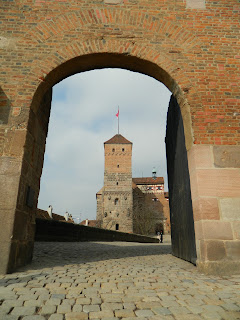Trip miles 1039
-1 overnight
We climbed up to the A9 150meters above Naumberg (and sea
level) and headed south through forests up slow gradual inclines. At 500 meters
Bertha clocked up 1000 trip miles and we celebrated with a roadside soup in
Frankische Schweiz. Spring or ‘Fruhling’ seemed a long season away and the only
things growing appeared to be the ice in the field-side ditches and the
mistletoe twining itself in giant balls in the tops of the trees.
 |
| Aire at Nuremberg |
In Nuremberg we headed straight to a free camping spot we
knew of at the edge of the city’s park, formerly the Nazi party rally grounds.
The annual Volksfest was in full swing and dodging the many stalls selling fried
German fairground favourites we went up in the Nuremberg ‘eye’ to get a full
look at the layout of the city and the scale of the historical rally site. A
warming glass of gluhwein was most welcome!
 |
| Volksfest in full swing next to Kongresshalle |
 |
| View from the top of the ferris wheel |
Walking the city the next day we admired the significant
post-war reconstruction of the centre which had been devastated by bombing
meted out by the allies in a concerted effort to destroy the cultural heart of
Nazism.
 |
| Only the cathedral remained partially standing after WWII |
The city, like Berlin, makes information about its dark
past freely and easily available. Archive photography is used to great effect
at historically important sites and information is provided to read in German
and English. The medieval street pattern was clear from high up on the ramparts
of the Imperial Palace, one of the most important centres of the Holy Roman
Empire and home to the treasury of the German kings who chose it as their
preferred residence during the Middle Ages.
 |
| Gateway into Imperial Palace |
The Nazis chose Nuremberg in which to base their ideology
of the ‘third Reich’ as the inheritor of the seat of the old Imperialism. In
the 1930s the city was still culturally important but also crucially working
class. The New Socialist Party held mass annual gatherings under the guise of
celebrating German working men and women but aimed at growing hatred of people
in other social groups which were seen as living an undeservedly better life at
the expense of the native Bavarian communities. At these rally grounds the scale of the PR
effort to sell these concepts to the public was clear. More than 200,000 people
would attend these gatherings at any one time.
 |
| Zeppelinfeld today |
 |
| Zeppelinfeld circa 1933 |
A half-finished Kongresshalle based on Rome’s Coliseum towers
over the surviving four square kilometre site which also includes the decaying
but awesome grandstand arena of the Zeppelinfeld where Hitler Youth, SS
officers, Party members and officials alike paraded to Hitler and his cronies.
The allies symbolically blew up the giant stone swastikas that topped the
Corinthian-styled columns, which have since been demolished for public safety.
Whilst joggers, skaters and an impromptu fitness class cheerily cruised and
gyrated past us we sat up on the grandstand imagining the scenes shown in
nearby black and white photographs of floodlit mass hysteria in front of the
Fuhrer. Ghastly.
 |
| At the Fuhrer's entrance on the grandstand |
The heart-warming sight of young locals noisily
trampolining and somersaulting to loud German pop radio at the edge of the
field was cheering and we watched the youngsters’ acrobatics whilst pigeon-chatting
with the Turkish trampoline owner and waiting for a hot coffee to brew. Dusk
settled over the park and as the ice spread at the edges of the dozen ponds we
finished a thought-provoking and enjoyable stay in a fascinating and endearing
city.
 |
| View across Hitler's "12 Ponds" towards Kongresshalle |

